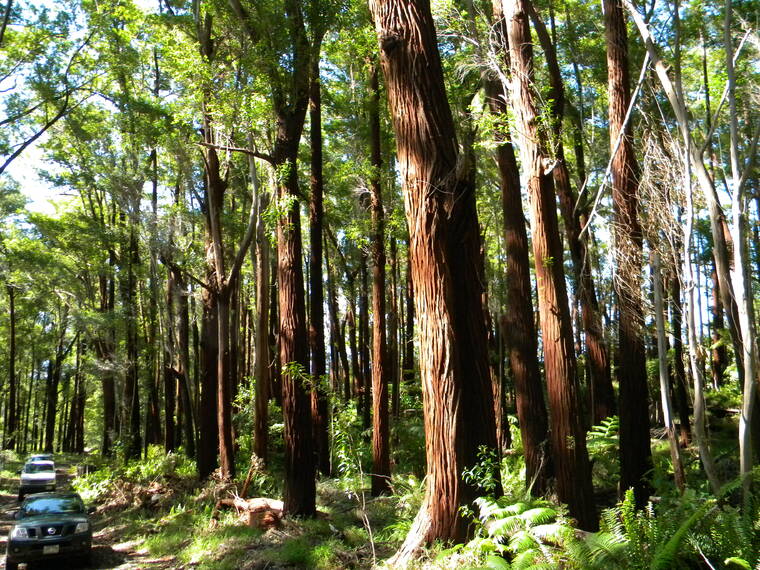State to harvest koa from Hawaii island forest to build canoes

WEST HAWAII TODAY/FILE PHOTO
Trees tower over vehicles on a dirt track on land owned by Edmund C. Olson Trust near the Ka‘u Forest Reserve.
A 1,200-acre koa forest on Hawaii island is almost ready to be harvested for the first time in nearly two decades.
The Kapapala Canoe Forest was set aside in 2005 within the Kau Forest Reserve to serve as a sustainable source for koa wood to be used to build traditional Hawaiian canoes, because organizations that build those canoes found it hard to source suitable trees amid a decline in koa resources in the state.
Since its establishment, however, no trees have been harvested from the 1,257-acre forest because of a lack of updated information about the area.
In 2019 the state Board of Land and Natural Resources — whose Division of Forestry and Wildlife manages the forest — signed off on an inventory of the forest to further understanding about its ecology and, eventually, develop a sustainable management plan to allow for harvesting.
That plan, published in April, estimates that roughly 5.5 million board feet of koa timber exist within the forest, based on data from the inventory. Of those, about 1 million board feet are in trees considered ideal for canoe log construction now, and another 1.5 million likely will be well suited for log construction in the next two decades.
To sustainably harvest wood from the forest, the plan states that trees will only be felled selectively. “High-grading,” or the practice of harvesting only the largest trees, is unsustainable over time. Therefore, any harvests for canoe logs will be accompanied by other noncommercial actions to thin the forest, including selective harvests of noncanoe trees.
Don't miss out on what's happening!
Stay in touch with breaking news, as it happens, conveniently in your email inbox. It's FREE!
Harvests will be largely carried out in priority areas along the roadsides within the forest reserve first, before eventually proceeding deeper into the forest over the next several decades.
Organizations within Hawaii will be able to submit applications to harvest trees from the forest. Applicants must be able to demonstrate that they are capable — both financially and technically — of processing a koa log into a canoe and submit their own stewardship plan that outlines any forest conservation or land stewardship activities the group is involved in.
Applications will then be reviewed by a selected board of experts, including cultural practitioners, members of voyaging and racing canoe associations, canoe builders, forestry experts, conservationists and more.
Meanwhile, DOFAW will identify which trees are available for harvest at the time of the application. Harvests will be restricted to only 10% of the total volume of the forest within 10 years, which will therefore limit the number and volume of trees removed annually.




